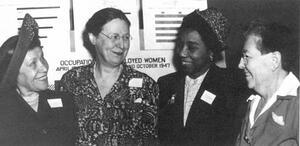Pauline Newman organizes influential New York rent strike
Institution: The Schlesinger Library, Radcliffe Institute, Harvard University
On December 26, 1907, months of organizing work by 16-year-old Pauline Newman culminated in the start of the largest rent strike New York City had ever seen. One reason for the strike's success was Newman's enlistment of neighborhood housewives. While working-class activists like Newman had to work during the day, the impassioned housewives that they organized could go from tenement to tenement to convince others to strike. Thus, the success of the strike depended both on shop floor networks of teenaged girls and on networks of neighborhood housewives and mothers.
The strike, involving 10,000 families in lower Manhattan, lasted only until January 9, but about 2,000 families succeeded in having their rents reduced. More importantly, the strike attracted the attention of leading figures in the settlement house movement who suggested capping rents at 30% of a family's income. Although their suggestion was not implemented, it introduced the idea of rent control to New York politics. The idea stayed alive into the 1930s, when rent control was finally implemented in New York City.
Newman's leadership of the strike began a lifetime of activism. It brought her to the attention of the Socialist party, which ran her as a candidate for secretary of state of New York the following year (despite the fact that women did not yet have the vote in New York). She used the opportunity to call for woman's suffrage. Newman also began organizing female garment workers and was a key organizer in the 1909 Uprising of the 20,000.
Sources: Jewish Women in America: An Historical Encyclopedia, pp. 993-996; Annelise Orleck, Common Sense and a Little Fire: Women and Working-Class Politics in the United States, 1900-1965 (Chapel Hill, NC, 1995).



